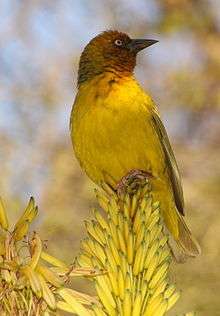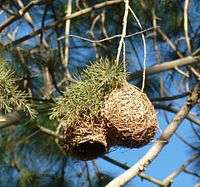Cape weaver
| Cape weaver | |
|---|---|
 | |
| Male in Johannesburg, South Africa | |
| Scientific classification | |
| Kingdom: | Animalia |
| Phylum: | Chordata |
| Class: | Aves |
| Order: | Passeriformes |
| Family: | Ploceidae |
| Genus: | Ploceus |
| Species: | P. capensis |
| Binomial name | |
| Ploceus capensis (Linnaeus, 1766)[2] | |
The Cape weaver (Ploceus capensis) is a resident breeding weaver of Southern Africa, it is almost endemic to South Africa.
Description


The Cape weaver is a stocky 17 cm long bird with streaked olive-brown upperparts and a long pointed conical bill. The breeding male has a yellow head and underparts, an orange face, and a white iris. The adult female has an olive-yellow head and breast, shading to pale yellow on the lower belly. Her eyes are brown, but 19% will have brown eyes. Young birds are similar to the female.[3]
Voice
The song of the Cape weaver is a harsh, rather hysterical sizzle. The alarm call is a sharp double chip and the contact call is a harsh "azwit".[4]
Distribution
The Cape weaver is Endemic to South Africa, Lesotho and Swaziland, occurring across much of the area excluding the Kalahari Desert from the Orange River in the Northern Cape south to the Cape of Good Hope then east to northern KwaZulu Natal and inland almost to Bloemfontein in the Orange Free State.[5]
Habitat
The Cape weaver occurs in open grassland, lowland fynbos, coastal thicket and farmland, so long as there is permanent water and trees.[5] In the more arid, hotter regions it is restricted to upland areas and it never occurs in forest.[3]
Habits
The Cape weaver is omnivorous with a diet that is evenly divided between animal and plant matter, particularly seeds, fruit and nectar. It forages in a variety of ways on the ground, in tree foliage, gleaning food from bark and hawking insects in the air. Its a relatively long bill is adapted to feeding on a wide variety of food items and there is a long list of items that this species has been recorded as eating, including various insects, spiders, seeds, nectar, and fruit. The females appear to enjoy a more varied diet than the males. Cape weavers are generalist nectar-feeders and in South Africa they are the major pollinators of aloes.[3][5]
When not breeding the Cape Weaver forms flocks, and it congregates in large roosts throughout the year, these may be shared with other birds, including other species of weavers. In some areas they desert the breeding colonies, returning at the commencement of the following breeding season. Anting has been observed and these birds bathe, even in rain or mist.[3]
The Cape weaver is a polygynous, territorial colonial nester, each males may have up to 7 females in a single breeding season. The males normally form colonies of between 2-20 males. Each male builds multiple nests within a small territory, which he vigorously defends against other males. Females test the quality of the construction of the nest by pulling at material on the interior; if it is acceptable the female adopts a hunched posture to indicate her readiness to mate. The nest is built by the male in about a week, and is a kidney-shaped, fully waterproof construction made of broad strips of grass or reeds that are woven together. Once a female accepts the nest the male builds an entrance tunnel at its base, while she lines the inside of the nest with fine grass and feathers. The nest is usually attached to the tip if a tree branch, often exotic species such as eucalyptus or willow or it is built in tall wetland vegetation such as reeds Phragmites or reedmace Typha capensis, on utility lines or on fences overlooking water.[5]
It lays a clutch of 2-5 eggs, the eggs are laid in June–February with a peak in October to January in summer rainfall areas and August–October in the winter rainfall zone of the Western Cape. The eggs are incubated by the female for about two weeks and fater hatching she broods for the first few nights, after which she roosts in an adjacent unused nest. At first the chicks are fed by the females, but when they are older the male takes up a greater role in providing food. The young fledge at about 17 days old.[5]
The Cape weaver is subjected to brood parasitism by the diederik cuckoo. The nests are sometimes heavily infested with parasites such as mites, and the fledglings can be parasitised by ticks.[5] Disused nests may be reused by Cape sparrows and African dusky flycatchers.[3]
Threats
The Cape weaver is not threatened, in fact it is common and can be a pest in the orchards and agricultural lands of the Western Cape, where it is occasionally killed in large numbers.[5]
References
- ↑ BirdLife International (2012). "Ploceus capensis". IUCN Red List of Threatened Species. Version 2013.2. International Union for Conservation of Nature. Retrieved 26 November 2013.
- ↑ "Ploceus capensis (Linnaeus, 1766)". Integrated Taxonomic Information System (ITIS) (http://www.itis.gov). Retrieved 2016-11-13.
- 1 2 3 4 5 "Cape Weaver Ploceus capensis". Weaver Watch. Animal Demography Unit. Retrieved 2016-11-13.
- ↑ "Cape Weaver". Oiseaux-Birds.com. Retrieved 2016-11-13.
- 1 2 3 4 5 6 7 "Ploceus capensis (Cape weaver)". Biodiversity Explorer. Iziko Museums of South Africa. Retrieved 2016-11-13.
- Sinclair, Hockey and Tarobton, SASOL Birds of Southern Africa, ISBN 1-86872-721-1
External links
| Wikimedia Commons has media related to Ploceus capensis. |
- Cape weaver - Species text in The Atlas of Southern African Birds
